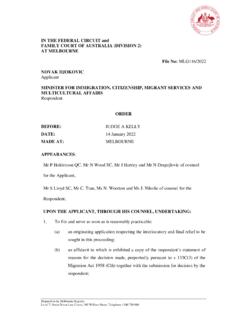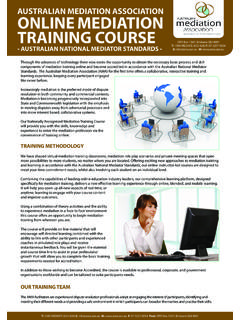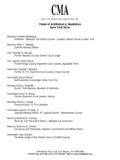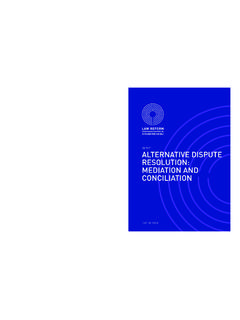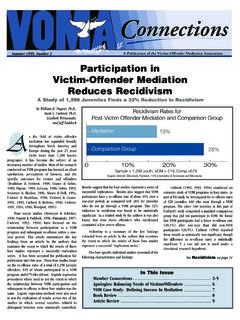Transcription of 190907 Practice Standards - Federal Court of Australia
1 AUSTRALIAN NATIONAL MEDIATOR Standards . Practice Standards . FOR MEDIATORS OPERATING UNDER THE NATIONAL MEDIATOR. ACCREDITATION SYSTEM. SEPTEMBER 2007. AUSTRALIAN NATIONAL MEDIATOR Standards Contents 1 Application .. 4. 2 Description of a mediation Process .. 5. 3 Starting a mediation Process .. 6. 4 Power Issues .. 8. 5 Impartial and Ethical Practice .. 8. 6 9. 7 Competence .. 10. 8 Inter-professional 11. 9 Procedural Fairness .. 12. 10 Information Provided by the 13. 11 Termination of the mediation Process .. 13. 12 Charges for Services .. 14. 13 Making Public Statements and Promotion of 14. Practice Standards , September 2007 3. AUSTRALIAN NATIONAL MEDIATOR Standards Practice Standards 1 Application 1) These Practice Standards apply to any mediator acting as a third party to support two or more individuals or entities to manage, settle or resolve disputes, or to form a future plan of action through a process of mediation and who voluntarily decides to become accredited under the National Mediator Accreditation Scheme.
2 Practitioners who act in these roles are referred to in these Practice Standards as mediators. A. mediator supports participants in a mediation process to identify, clarify and explore issues, to generate and consider options and to make decisions about future actions and outcomes. The Practice Standards are intended to govern the relationship of mediators with the participants in the mediation , their professional colleagues, courts and the general public so that all will benefit from high Standards of Practice in mediation . 2) The Practice Standards : a) specify Practice and competency requirements for mediators; and b) inform participants and others about what they can expect of the mediation process and mediators.
3 3) Mediators voluntarily accredited under the Australian National Mediator Standards must comply with the Approval Standards as well as the Practice Standards . These Practice Standards should be read in conjunction with the Approval Standards . 4) There are a range of different mediation models in use across Australia . As noted in the Approval Standards , mediation can take place in all areas where decisions are made. For example, mediation is used in relation to commercial, community, workplace, environmental, construction, family, building, health and educational decision making. mediation may be used where there is conflict or may be used to support future decision making. Mediators are drawn from diverse backgrounds and disciplines.
4 mediation may take place as a result of Court or Tribunal referral, pre- litigation schemes, through industry schemes, community based schemes as well as through private referral, agency, self or other referral. These Practice Standards set out minimum Practice requirements and recognise that some mediators who Practice in particular areas of with particular models may choose to develop or comply with additional Standards or requirements. Mediators may Practice as solo' mediators or may co-mediate with another mediator. Practice Standards , September 2007 4. AUSTRALIAN NATIONAL MEDIATOR Standards 5) Where mediators Practice under existing legislative frameworks and there is a conflict between the requirements of these Practice Standards and any legislation, the respective legislative requirements will override those of the Practice Standards to the extent of any inconsistency.
5 2 Description of a mediation Process The purpose of a mediation process is to maximise participants' decision making. 1) A mediation process is a process in which the participants, with the support of a mediator, identify issues, develop options, consider alternatives and make decisions about future actions and outcomes. The mediator acts as a third party to assist the participants to reach their decision. 2) mediation processes are not a substitute for individual or organisational legal and/or other expert advice, or individual counselling or therapy. mediation processes may not be appropriate for all disputants or all types of disputes. 3) The goal of a mediation process is agreed upon by the participants with the assistance of the mediator.
6 Examples of goals may include assisting the participants to make a wise decision, to clarify the terms of a workable agreement and/or future patterns of communication that meet the participants' needs and interests, as well as the needs and interests of others who are affected by the dispute. 4) The mediation process may: a) assist the participants to define and clarify the issues under consideration;. b) assist participants to communicate and exchange relevant information;. c) invite the clarification of issues and disputes to increase the range of options;. d) provide opportunities for understanding;. e) facilitate an awareness of mutual and individual interests;. f) help the participants generate and evaluate various options; and g) promote a focus on the interests and needs of those who may be subject to, or affected by, the situation and proposed options.
7 5) Mediators do not advise upon, evaluate or determine disputes. They assist in managing the process of dispute and conflict resolution whereby the participants agree upon the outcomes, when appropriate. mediation is essentially a process that maximises the self determination of the participants. The principle of self determination requires that mediation processes be non-directive as to content. 6) Some mediation processes may involve participants seeking expert information from a mediator which will not infringe upon participant self-determination. Such information is deemed to be consistent with a mediation process if that information is couched in general and non-prescriptive terms, and presented at a stage of the process which enables participants to integrate it into their decision making.
8 Such information might include the provision of general information and a reference to available material that could assist the participants. For example, a referral to resources that could be used by parents in a family dispute to determine the impact of options upon children or other family members. Practice Standards , September 2007 5. AUSTRALIAN NATIONAL MEDIATOR Standards 7) Some mediators may use a blended process' model whereby they provide advice. These processes are sometimes referred to as advisory mediation ', evaluative mediation ' or conciliation'. Such processes may involve the provision of expert information and advice, provided it is given in a manner that enhances the principle of self-determination and provided that the participants request that such advice be provided.
9 Mediators who provide expert advice are required to have appropriate expertise (see Approval Standards at Section 5 (4)) and to obtain the consent of participants prior to providing any advisory process. 3 Starting a mediation Process Before mediating, a mediator should ensure that an outline of the mediation process has been given to the participants. 1) The diversity in mediation Practice means that there are considerable differences in terms of how participants enter into a mediation process. Where mediators are bound by existing professional or organisational requirements relating to entry into a mediation process and to the extent that such professional or organisational requirements contradict with the Practice Standards , the existing professional or organisational requirements should prevail.
10 2) Prior to the mediation taking place, the mediator will ensure that the participants have been provided with an explanation of the process and have had an opportunity to reach agreement about the way in which the process is to be conducted. This may take place in an intake process that is held separately from a mediation session. The person conducting the intake process may be a different person to the mediator. 3) The objectives of an intake process may include: a) Determining whether mediation is appropriate and whether variations are required (for example, using an interpreter or a co- mediation model in culturally and linguistically diverse communities or varying arrangements where violence is an issue). b) Assisting the participants to prepare for the process.
